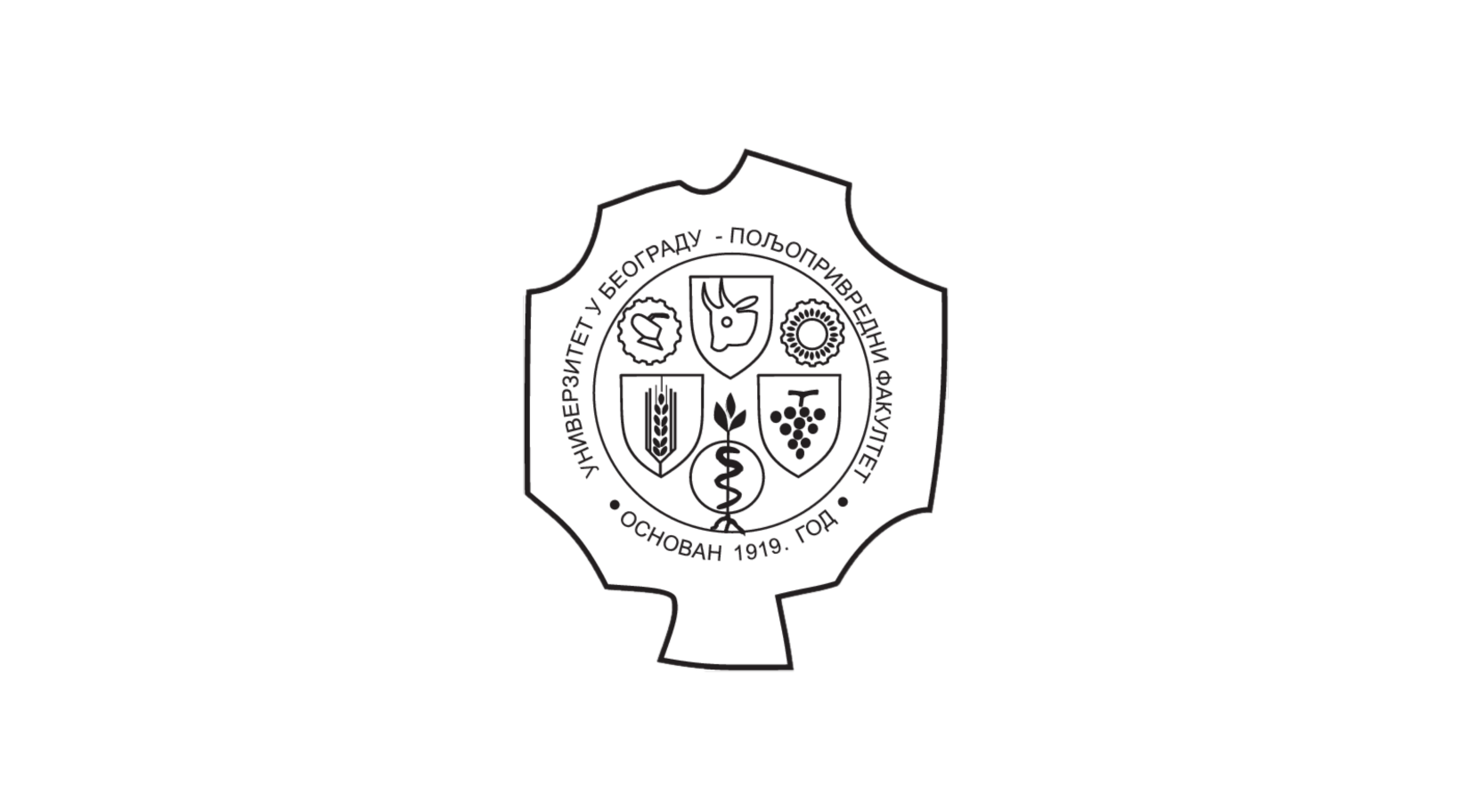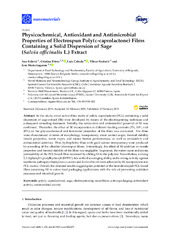Physicochemical, Antioxidant and Antimicrobial Properties of Electrospun Poly(epsilon-caprolactone) Films Containing a Solid Dispersion of Sage (Salvia officinalis L.) Extract
Апстракт
In this study, novel active films made of poly(epsilon-caprolactone) (PCL) containing a solid dispersion of sage extract (SE) were developed by means of the electrospinning technique and subsequent annealing treatment. Initially, the antioxidant and antimicrobial potential of SE was confirmed. Thereafter, the effect of SE incorporation at different loading contents (5%, 10%, and 20%) on the physicochemical and functional properties of the films was evaluated. The films were characterized in terms of morphology, transparency, water contact angle, thermal stability, tensile properties, water vapor, and aroma barrier performances, as well as antioxidant and antimicrobial activities. Thin, hydrophobic films with good contact transparency were produced by annealing of the ultrathin electrospun fibers. Interestingly, the effect of SE addition on tensile properties and thermal stability of the films was negligible. In general, the water vapor and aroma permeability of the PCL-based films incr...eased by adding SE to the polymer. Nevertheless, a strong 2,2-diphenyl-1-picrylhydrazyl (DPPH center dot) free radical scavenging ability, and a strong activity against foodborne pathogens Staphylococcus aureus and Escherichia coli were achieved by SE incorporation into PCL matrix. Overall, the obtained results suggest great potential of the here-developed PCL-based films containing SE in active food packaging applications with the role of preventing oxidation processes and microbial growth.
Кључне речи:
Poly(epsilon-caprolactone) / sage / electrospinning / nanofibers / active packaging / antioxidant activity / antimicrobial activityИзвор:
Nanomaterials, 2019, 9, 2Издавач:
- MDPI, BASEL
Финансирање / пројекти:
- COST ActionEuropean Cooperation in Science and Technology (COST) [FP1405, 39168]
- EUEuropean Union (EU) [730349]
- Развој нових инкапсулационих и ензимских технологија за производњу биокатализатора и биолошки активних компонената хране у циљу повећања њене конкурентности, квалитета и безбедности (RS-MESTD-Integrated and Interdisciplinary Research (IIR or III)-46010)
DOI: 10.3390/nano9020270
ISSN: 2079-4991
PubMed: 30781390
WoS: 000460806700139
Scopus: 2-s2.0-85065230591
Институција/група
Poljoprivredni fakultetTY - JOUR AU - Salević, Ana AU - Prieto, Cristina AU - Cabedo, Luis AU - Nedović, Viktor AU - Maria Lagaron, Jose PY - 2019 UR - http://aspace.agrif.bg.ac.rs/handle/123456789/5122 AB - In this study, novel active films made of poly(epsilon-caprolactone) (PCL) containing a solid dispersion of sage extract (SE) were developed by means of the electrospinning technique and subsequent annealing treatment. Initially, the antioxidant and antimicrobial potential of SE was confirmed. Thereafter, the effect of SE incorporation at different loading contents (5%, 10%, and 20%) on the physicochemical and functional properties of the films was evaluated. The films were characterized in terms of morphology, transparency, water contact angle, thermal stability, tensile properties, water vapor, and aroma barrier performances, as well as antioxidant and antimicrobial activities. Thin, hydrophobic films with good contact transparency were produced by annealing of the ultrathin electrospun fibers. Interestingly, the effect of SE addition on tensile properties and thermal stability of the films was negligible. In general, the water vapor and aroma permeability of the PCL-based films increased by adding SE to the polymer. Nevertheless, a strong 2,2-diphenyl-1-picrylhydrazyl (DPPH center dot) free radical scavenging ability, and a strong activity against foodborne pathogens Staphylococcus aureus and Escherichia coli were achieved by SE incorporation into PCL matrix. Overall, the obtained results suggest great potential of the here-developed PCL-based films containing SE in active food packaging applications with the role of preventing oxidation processes and microbial growth. PB - MDPI, BASEL T2 - Nanomaterials T1 - Physicochemical, Antioxidant and Antimicrobial Properties of Electrospun Poly(epsilon-caprolactone) Films Containing a Solid Dispersion of Sage (Salvia officinalis L.) Extract IS - 2 VL - 9 DO - 10.3390/nano9020270 ER -
@article{
author = "Salević, Ana and Prieto, Cristina and Cabedo, Luis and Nedović, Viktor and Maria Lagaron, Jose",
year = "2019",
abstract = "In this study, novel active films made of poly(epsilon-caprolactone) (PCL) containing a solid dispersion of sage extract (SE) were developed by means of the electrospinning technique and subsequent annealing treatment. Initially, the antioxidant and antimicrobial potential of SE was confirmed. Thereafter, the effect of SE incorporation at different loading contents (5%, 10%, and 20%) on the physicochemical and functional properties of the films was evaluated. The films were characterized in terms of morphology, transparency, water contact angle, thermal stability, tensile properties, water vapor, and aroma barrier performances, as well as antioxidant and antimicrobial activities. Thin, hydrophobic films with good contact transparency were produced by annealing of the ultrathin electrospun fibers. Interestingly, the effect of SE addition on tensile properties and thermal stability of the films was negligible. In general, the water vapor and aroma permeability of the PCL-based films increased by adding SE to the polymer. Nevertheless, a strong 2,2-diphenyl-1-picrylhydrazyl (DPPH center dot) free radical scavenging ability, and a strong activity against foodborne pathogens Staphylococcus aureus and Escherichia coli were achieved by SE incorporation into PCL matrix. Overall, the obtained results suggest great potential of the here-developed PCL-based films containing SE in active food packaging applications with the role of preventing oxidation processes and microbial growth.",
publisher = "MDPI, BASEL",
journal = "Nanomaterials",
title = "Physicochemical, Antioxidant and Antimicrobial Properties of Electrospun Poly(epsilon-caprolactone) Films Containing a Solid Dispersion of Sage (Salvia officinalis L.) Extract",
number = "2",
volume = "9",
doi = "10.3390/nano9020270"
}
Salević, A., Prieto, C., Cabedo, L., Nedović, V.,& Maria Lagaron, J.. (2019). Physicochemical, Antioxidant and Antimicrobial Properties of Electrospun Poly(epsilon-caprolactone) Films Containing a Solid Dispersion of Sage (Salvia officinalis L.) Extract. in Nanomaterials MDPI, BASEL., 9(2). https://doi.org/10.3390/nano9020270
Salević A, Prieto C, Cabedo L, Nedović V, Maria Lagaron J. Physicochemical, Antioxidant and Antimicrobial Properties of Electrospun Poly(epsilon-caprolactone) Films Containing a Solid Dispersion of Sage (Salvia officinalis L.) Extract. in Nanomaterials. 2019;9(2). doi:10.3390/nano9020270 .
Salević, Ana, Prieto, Cristina, Cabedo, Luis, Nedović, Viktor, Maria Lagaron, Jose, "Physicochemical, Antioxidant and Antimicrobial Properties of Electrospun Poly(epsilon-caprolactone) Films Containing a Solid Dispersion of Sage (Salvia officinalis L.) Extract" in Nanomaterials, 9, no. 2 (2019), https://doi.org/10.3390/nano9020270 . .




